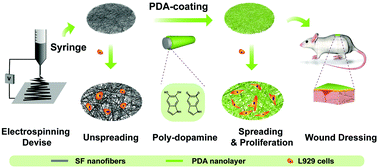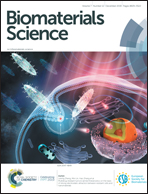Polydopamine modification of silk fibroin membranes significantly promotes their wound healing effect†
Abstract
Natural polymer-based wound dressings have gained great attention in skin tissue engineering. Silk fibroin (SF) spun from Bombyx mori (B. mori) is a potential wound dressing material due to its outstanding biocompatibility and biodegradability, however, its wound healing effect is still limited. To maximize the wound healing effect of SF-based wound dressing, we first fabricated fibrous electrospun SF (ESF) membranes with large porosity and specific surface area, and then formed polydopamine (PDA) coating on the ESF fibers to form PESF membranes. We found that PDA coating enabled the PESF membranes to outperform the ESF membranes in enhancing the hydrophilicity and protein adsorption ability of the membranes as well as the attachment, spreading and proliferation of fibroblasts on the membranes in vitro. Our further in vivo histological analysis confirmed that the PESF membranes accelerated wound healing in a rat skin wound model more effectively within 2 weeks than both the ESF membrane and a commercial dressing (3M™ Tegaderm™). The enhanced wound healing effect of the PESF membranes was further proved by the increase in the content of hydroxyproline (a constituent in collagen) in the wound treated by the PESF membranes. Therefore, the PESF membranes could be used as a promising wound dressing for wound healing and skin regeneration.



 Please wait while we load your content...
Please wait while we load your content...